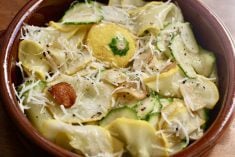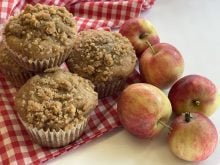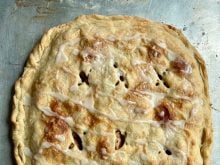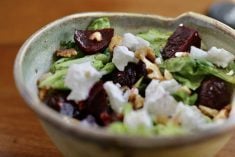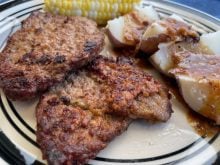Root cellars and cold rooms are not as common as they once were, but many families still maintain them. Now is a good time to take stock and decide what needs to be used before spoilage occurs.
In addition to checking vegetables and apples, take a look at the dates on your canning. Ideally it should be used within a year of putting it down. Perhaps a few jars should be used sooner rather than later.
Carrot and beet slaw
To avoid carrots and almonds being coloured by the beets, combine and toss just before serving.
Read Also

Producer profits remain under significant pressure
Manitoba farmers are facing down a double hit of high input costs, like fertilizer, and low grain prices as they harvest their next crop.
- 3/4 c. golden raisins 175 mL
- 1/4 c. apple cider or red wine vinegar 60 mL
- 6 medium carrots, peeled and shredded
- 2 medium beets, peeled and shredded
- 1/2 c. packed, fresh flat leaf parsley, coarsely chopped 125 mL
- 1/4 c. slivered almonds 60 mL
- 3 tbsp. lemon juice 45 mL
- salt, pepper
- 1/3 c. canola or olive oil 75 mL
- 1 tbsp. honey, optional 15 mL
Combine raisins and vinegar in a large bowl and let sit for one hour. Add carrots, beets, parsley and lemon juice. Add oil and toss. Taste and season with salt, pepper and honey, if using. Serve right away.
Slow Cooker Caramelized Onions
The slow cooker makes perfect caramelized onions. They can be used for soups, pastas and on top of burgers. Make a big batch because it takes a lot of time. They freeze well for future use.
- 2-3 large sweet onions, sliced
- 1/4 c. canola or olive oil 60 mL
- 1/2 tsp. salt 2 mL
Place sliced onions in slow cooker with oil and salt. Stir to coat. Cook on low for about 10 hours or until they reach the stage of caramelization you like. They may be used right away, refrigerated for a few days or frozen for future use.
Parsnip and lentil salad with walnuts
- 6 parsnips
- 4 c. vegetable stock 1 L
- 1 c. small green or beluga lentils 250 mL
- 1 bay leaf
- 1/4 c. walnuts 60 mL
- 2 tbsp. canola or olive oil 30 mL
For the dressing:
- 3 tbsp. walnut oil 45 mL
- 1 tbsp. red wine vinegar 15 mL
- 2 tsp. liquid honey 10 mL
- 1/2 tsp. Dijon mustard 2 mL
- 1 shallot
- 1/2 clove garlic
- arugula
- a few shavings of hard cheese, to serve
Preheat the oven to 400 F (200 C). Peel and trim the parsnips, cutting them into batons approximately two inches (5 cm) long and one half inch (1 cm) thick. Finely dice the shallot and crush the garlic for the dressing.
Bring the stock to the boil, add lentils and bay leaf and simmer gently for 25 to 30 minutes, or until the lentils are just tender but still retain some bite. Drain the lentils, discard the bay leaf and set lentils aside to cool.
Place the walnuts on a baking sheet and toast in the oven until lightly browned and fragrant. Remove from the oven, set walnuts aside. Using the same baking sheet, place the parsnips. Drizzle with the oil and roast for 35 minutes, until golden.
Make the dressing by adding the walnut oil, vinegar, honey and mustard to a one cup (250 mL) lidded jar. Season with salt and pepper, to taste, and stir in the garlic and shallots.
In a bowl, toss together the lentils, walnuts, parsnips and dressing. Place the arugula onto plates, pile on the lentil salad and shave some hard cheese. Serve.
Squash soup
Use any type of squash or pumpkin on hand.
- 2 tbsp. unsalted butter or your favourite cooking oil 30 mL
- 1 c. chopped onion 250 mL
- 2 1/2 lb. squash, peeled, seeded, and cubed (about 6 cups) 1.5 L
- 1/2 Granny Smith apple, peeled, cored, and diced
- 3 c. chicken stock 750 mL
- 1 c. apple cider 250 mL
- 1/2 tsp. dried thyme 2 mL
- kosher salt and freshly ground pepper
- spiced popcorn or croutons, for garnish
Melt the butter in a large pot over medium-high heat. Add the onions and sauté until softened, about five minutes. Add the squash and apple and sauté for five more minutes. Add the remaining ingredients and bring the mixture to a boil.
Reduce heat to a simmer, cover and cook until the squash is tender, about 20 minutes. Remove from heat.
In small batches, carefully purée the soup in a blender or food processor until very smooth. Serve immediately or refrigerate for up to three days. Will keep in the freezer for three months.
To make your own spiced popcorn, toss freshly popped kernels with melted butter and sprinkle liberally with cayenne, cumin, curry and salt.
Garlic confit
Confiting is a French method for covering foods in fat and cooking them at low heat until tender and richly flavoured. The raw garlic cloves may be submerged in savoury animal fat, extra-virgin olive oil or, as in this recipe, a neutral oil like canola, which will allow the naturally sweet flavour of the cooked garlic to really shine.
To easily peel the garlic, cover the unpeeled cloves with very hot water for a few minutes. Their skins will slip right off.
Add garlic confit to mashed potatoes or hummus, spread on sourdough toast or mash with butter to serve with grilled steak. Keep the oil from the confit to use in salad dressings, marinades or basting vegetables for the grill.
The confit can be stored in the refrigerator for seven to 10 days or in the freezer for three months.
- 3 heads of garlic, cloves peeled
- 1 1/2 c. canola oil, approximately
Preheat oven to 250 F (120 C). Place garlic and oil in a small ovenproof saucepan. Use just enough oil to cover the cloves. Cover and bake until cloves are golden and tender, about one and a half hours. Let cool. Transfer garlic and oil to an airtight container and chill.
Sarah Galvin is a home economist, teacher and avid supporter of local food producers. She has been a market vendor, grew up on a farm in southeastern Saskatchewan and is a member of TEAM Resources.







